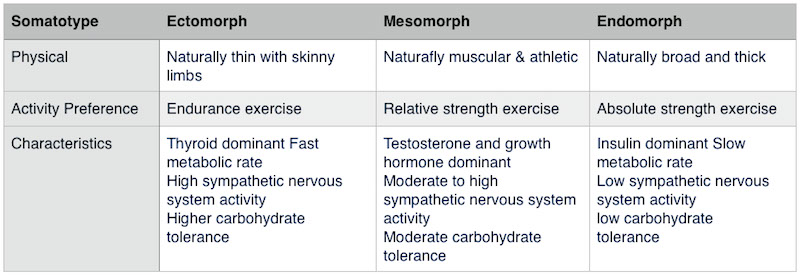Somatotype is a term used to categorize body types into 3 primary categories. The concept of somatotypes was first introduced by William H. Sheldon, PhD, MD, in the 1940’s however others have presented the idea even earlier it was Sheldon in “The Varieties of Human Physique”, that further refined the concept so that could could be applied for research basis. Somatotyping has been used by nutritionists, exercise physiologists, and doctors to help design effective, individualized health & wellness plans ever since but it does seem that the science of somatotypying has been lost (or at least misplaced) and it has been over generalized thus losing credibility.
Most people are unique combinations of the 3 body types.
- Ectomorph
- Mesomorph
- Endomorph
Somatotypes were originally referred to as genotypes, however due to the influence the environmental has on an individual’s somatotype and the fact the an individual’s somatotype can change throughout life it is more accurately now referred to as phenotypes.
Lifestyle and the environment, including training and nutrition can create a shift in the dominant somatotype.

Ectomorph Characteristics
(Generalizations)
- Naturally skinny, wiry
- Long limbs, linear
- Small joints, small-boned
- Small waist, narrow shoulders
- Angular, projecting bones
- Naturally lean (low levels of body fat without even working out) Often call themselves “Hardgainers”.
- Low strength levels prior to starting a training program
- Fast metabolism – they burn up everything, even when overeating
- Carbohydrate tolerant
- High energy levels
- Tendency to hyperactivity
- More attracted to endurance sports/activities.
- Sometimes hard to maintain weight
- Extremely hard to gain weight
- Occasionally insomniacs
- Tend to respond best to low volume, brief, infrequent, high intensity weight training.

Mesomorph Characteristics
(Generalizations)
- Medium joint circumference
- Small waist
- Broad/square shoulders
- Chest dominates over abdominal area
- Naturally lean (low levels of body fat without even working out).
- Naturally muscular (muscular before they even started working out).
- Naturally strong (strong before they even started working out).
- High energy levels
- Carbohydrate tolerant
- Controlling body fat is easy
- Gaining strength is easy
- Gaining muscle is easy
- Losing body fat is easy
- Responds very quickly to just about any type of training (fast results)
- Natural born athlete (successful at strength and power sports).
- Top-level professional bodybuilders are often pure mesomorphs.

Endomorph Characteristics
(Generalizations)
- Naturally high levels of body fat (often overweight)
- Usually large boned, large joints, large frame
- Short, tapering arms and legs
- Smooth, round body contours (round or pear shaped body)
- Wide waist and hips Waist dominates over chest.
- Tendency to always store excess calories as fat (can’t get away with overeating)
- Keeping fat off after it is lost is a challenge.
- Tendency to be sluggish, slow moving and lacking energy
- Slow thyroid or other hormone imbalance (sometimes)
- Fairly good strength levels
- Carbohydrate intolerant – Sensitive to carbohydrates (carbs are easily stored as fat)
- Responds better to diets with higher protein and low (or moderate) carbs.
- Naturally slow metabolic rate/low set point (fewer calories burned at rest)
- Falls asleep easily and sleeps deeply
- A lot of cardio is necessary to lose weight and body fat
- Extremely difficult to lose weight (requires great effort)
- Bouts of fatigue and tiredness
- Often describe themselves as having a “slow metabolism”
- Tendency to gain fat easily as soon as exercise is stopped
- Tendency to lose fat slowly, even on a “clean,” low fat, low calorie diet.
- Often overweight, even though they don’t eat very much
- Respond best to frequent, even daily, training.

